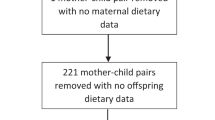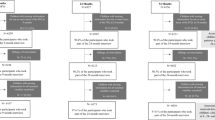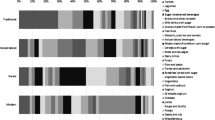Abstract
Background/Objectives
The usual definition of dietary patterns only accounts for the explanation of dietary choices and not a specific health outcome. This could partially explain the lack of consistent associations between diet and related diseases. This study aims to identify dietary patterns in 7 years olds explaining body mass index (BMI) at age 10 and to assess their association with early-life factors (sociodemographic, birth, and infancy characteristics).
Methods
Children from the birth cohort Generation XXI at ages 7 and 10 were included (n = 4698). Diet was assessed by a validated food-frequency questionnaire. Measured BMI z-scores (zBMI) were calculated. Principal component analysis (PCA) and partial least squares (PLS) were run to derive dietary patterns.
Results
The component scores of PCA was able to explain 13.0% of food groups and only 0.2% of zBMI, while the PLS scores explained the variance of both food groups (10.1%) and zBMI at age 10 (4.2%). By using PLS, two dietary patterns were derived, but only one, higher in processed meats and energy-dense foods and lower in vegetable soup consumption, was significantly associated with an increased zBMI in 10 years olds (adjusted β̂ 0.032; 95% CI:0.017; 0.047). It was more likely followed by children from younger and less educated mothers and who were born heavier.
Conclusions
A dietary pattern higher in processed and energy-dense foods and with lower vegetable soup intake in 7 years olds significantly explained zBMI of 10 years olds, and was predicted by early-life characteristics. The other dietary patterns were not significantly associated with zBMI at age 10.
This is a preview of subscription content, access via your institution
Access options
Subscribe to this journal
Receive 12 print issues and online access
$259.00 per year
only $21.58 per issue
Buy this article
- Purchase on Springer Link
- Instant access to full article PDF
Prices may be subject to local taxes which are calculated during checkout


Similar content being viewed by others
References
World Health Organization. Obesity and overweight fact sheet. World Health Organization; 2020 http://www.who.int/mediacentre/factsheets/fs311/en/. Accessed 11 Jan 2021.
Katz DL, Meller S. Can we say what diet is best for health? Annu Rev Public Health. 2014;35:83–103.
Emmett PM, Jones LR. Diet, growth, and obesity development throughout childhood in the Avon Longitudinal Study of Parents and Children. Nutr Rev. 2015;73:175–206.
Previdelli ÁN, de Andrade SC, Fisberg RM, Marchioni DM. Using two different approaches to assess dietary patterns: hypothesis-driven and data-driven analysis. Nutrients. 2016;8:593.
Michels KB, Schulze MB. Can dietary patterns help us detect diet-disease associations? Nutr Res Rev. 2005;18:241–8.
Tucker KL. Dietary patterns, approaches, and multicultural perspective. Appl Physiol, Nutr, Metab. 2010;35:211–8.
Hodge A, Bassett J. What can we learn from dietary pattern analysis? Public Health Nutr. 2016;19:191–4.
Fransen HP, Ocke MC. Indices of diet quality. Curr Opin Clin Nutr Metab Care. 2008;11:559–65.
Oude Griep LM, Wang H, Chan Q. Empirically-derived dietary patterns, diet quality scores, and markers of inflammation and endothelial dysfunction. Curr Nutr Rep. 2013;2:97–104.
Ocke MC. Evaluation of methodologies for assessing the overall diet: dietary quality scores and dietary pattern analysis. Proc Nutr Soc. 2013;72:191–9.
Durao C, Severo M, Oliveira A, Moreira P, Guerra A, Barros H, et al. Association between dietary patterns and adiposity from 4 to 7 years of age. Public Health Nutr. 2017;20:1973–82.
Pinto A, Santos AC, Lopes C, Oliveira A. Dietary patterns at 7 year-old and their association with cardiometabolic health at 10 year-old. Clin Nutr. 2020;39:1195–202.
Voortman T, Leermakers ETM, Franco OH, Jaddoe VWV, Moll HA, Hofman A, et al. A priori and a posteriori dietary patterns at the age of 1 year and body composition at the age of 6 years: the Generation R Study. Eur J Epidemiol. 2016;31:775–83.
Jessri M, Wolfinger RD, Lou WY, L’Abbe MR. Identification of dietary patterns associated with obesity in a nationally representative survey of Canadian adults: application of a priori, hybrid, and simplified dietary pattern techniques. Am J Clin Nutr. 2017;105:669–84.
Weikert C, Schulze MB. Evaluating dietary patterns: the role of reduced rank regression. Curr Opin Clin Nutr Metab Care. 2016;19:341–6.
Melaku YA, Gill TK, Taylor AW, Adams R, Shi Z. A comparison of principal component analysis, partial least-squares and reduced-rank regressions in the identification of dietary patterns associated with bone mass in ageing Australians. Eur J Nutr. 2018;57:1969–83.
Yang TC, Aucott LS, Duthie GG, Macdonald HM. An application of partial least squares for identifying dietary patterns in bone health. Arch Osteoporos. 2017;12:63.
Naja F, Itani L, Hwalla N, Sibai AM, Kharroubi SA. Identification of dietary patterns associated with elevated blood pressure among Lebanese men: a comparison of principal component analysis with reduced rank regression and partial least square methods. PLoS ONE. 2019;14:e0220942.
Lo YL, Pan WH, Hsu WL, Chien YC, Chen JY, Hsu MM, et al. Partial least square discriminant analysis discovered a dietary pattern inversely associated with nasopharyngeal carcinoma risk. PLoS ONE. 2016;11:e0155892.
Shakya PR, Melaku YA, Page A, Gill TK. Association between dietary patterns and adult depression symptoms based on principal component analysis, reduced-rank regression and partial least-squares. Clin Nutr. 2019;39:2811–23.
Ng A, Jessri M, L’Abbé M. Identification of an obesogenic dietary pattern using partial least squares in a nationally-representative sample of Canadian adults. Curr Dev Nutr. 2020;4:552.
Larsen PS, Kamper-Jorgensen M, Adamson A, Barros H, Bonde JP, Brescianini S, et al. Pregnancy and birth cohort resources in europe: a large opportunity for aetiological child health research. Paediatr Perinat Epidemiol. 2013;27:393–414.
Alves E, Correia S, Barros H, Azevedo A. Prevalence of self-reported cardiovascular risk factors in Portuguese women: a survey after delivery. Int J Public Health. 2012;57:837–47.
Vilela S, Severo M, Moreira T, Ramos E, Lopes C. Evaluation of a short food frequency questionnaire for dietary intake assessment among children. Eur J Clin Nutr. 2019;73:679–91.
Gibson RS. Principles of nutritional assessment. New York: Oxford University Press; 2005.
World Health Organization. BMI-for-age (5–19 years). World Health Organization; 2007. http://www.who.int/growthref/who2007_bmi_for_age/en/. Accessed 11 Jan 2021.
Mevik B-H, Wehrens R. The pls package: principal component and partial least squares regression in R. J Stat Softw. 2007;18:1–23.
Raîche G, Walls T, Magis D, Riopel M, Blais J-G. Non-graphical solutions for Cattell’s scree test. Methodology. 2013;9:23–9.
van der Voet H. Comparing the predictive accuracy of models using a simple randomization test. Chemom Intell Lab Syst. 1994;25:313–23.
Leventakou V, Sarri K, Georgiou V, Chatzea V, Frouzi E, Kastelianou A, et al. Early life determinants of dietary patterns in preschool children: Rhea Mother-Child Cohort, Crete, Greece. Eur J Clin Nutr. 2016;70:60–5.
Ambrosini GL. Childhood dietary patterns and later obesity: a review of the evidence. Proc Nutr Soc. 2014;73:137–46.
Leermakers ETM, van den Hooven EH, Franco OH, Jaddoe VWV, Moll HA, Kiefte-de Jong JC, et al. A priori and a posteriori derived dietary patterns in infancy and cardiometabolic health in childhood: the role of body composition. Clin Nutr. 2017;37:1589–95.
Keller A, Bucher Della Torre S. Sugar-sweetened beverages and obesity among children and adolescents: a review of systematic literature reviews. Child Obes. 2015;11:338–46.
Deren K, Weghuber D, Caroli M, Koletzko B, Thivel D, Frelut ML, et al. Consumption of sugar-sweetened beverages in paediatric age: a position paper of the European Academy of Paediatrics and the European Childhood Obesity Group. Ann Nutr Metab. 2019;74:296–302.
Slavin JL, Lloyd B. Health benefits of fruits and vegetables. Adv Nutr. 2012;3:506–16.
ala JR, Kraft P, McGarvey ST, Goldberg R, Campos H, Baylin A. Comparison of 3 methods for identifying dietary patterns associated with risk of disease. Am J Epidemiol. 2008;168:1433–43.
Chiavaroli V, Derraik JG, Hofman PL, Cutfield WS. Born large for gestational age: bigger is not always better. J Pediatr. 2016;170:307–11.
Husted JA, Cook RJ, Farewell VT, Gladman DD. Methods for assessing responsiveness: a critical review and recommendations. J Clin Epidemiol. 2000;53:459–68.
Ambrosini GL, Emmett PM, Northstone K, Jebb SA. Tracking a dietary pattern associated with increased adiposity in childhood and adolescence. Obesity. 2014;22:458–65.
Movassagh EZ, Baxter-Jones ADG, Kontulainen S, Whiting SJ, Vatanparast H. Tracking dietary patterns over 20 years from childhood through adolescence into young adulthood: the Saskatchewan Pediatric Bone Mineral Accrual Study. Nutrients. 2017;9:990.
Acknowledgements
The authors are indebted to all participants for providing the data used in the Generation XXI birth cohort, as well to all members of the research team and its coordinators. The authors acknowledge the support from the Epidemiology Research Unit (EPI-Unit: UID-DTP/04750/2013; POCI-01-0145-FEDER-006862).
Funding
Generation XXI was funded by the Health Operational Programme—Saúde XXI, Community Support Framework III, and the Regional Department of Ministry of Health. This study was supported through FEDER from the Operational Programme Factors of Competitiveness—COMPETE and through national funding from the Foundation for Science and Technology—FCT (Portuguese Ministry of Education and Science) under the projects “Appetite and adiposity—evidence for gene-environment interplay in children” (IF/01350/2015) and “Appetite regulation and obesity in childhood: a comprehensive approach towards understanding genetic and behavioral influences” (POCI-01-0145-FEDER-030334; PTDC/SAU-EPI/30334/2017) and through the Investigator Contract (IF/01350/2015—AO). This study was also supported by the Calouste Gulbenkian Foundation.
Author information
Authors and Affiliations
Contributions
AP performed statistical analyses and data interpretation and wrote the paper. MS performed statistical analyses and data interpretation. AO designed and conducted research and had primary responsibility for final content. All authors read and approved the final manuscript.
Corresponding author
Ethics declarations
Conflict of interest
The authors declare no competing interests.
Additional information
Publisher’s note Springer Nature remains neutral with regard to jurisdictional claims in published maps and institutional affiliations.
Supplementary information
Rights and permissions
About this article
Cite this article
Pinto, A., Severo, M. & Oliveira, A. Use of a hybrid method to derive dietary patterns in 7 years olds with explanatory ability of body mass index at age 10. Eur J Clin Nutr 75, 1598–1606 (2021). https://doi.org/10.1038/s41430-021-00883-9
Received:
Revised:
Accepted:
Published:
Issue Date:
DOI: https://doi.org/10.1038/s41430-021-00883-9



